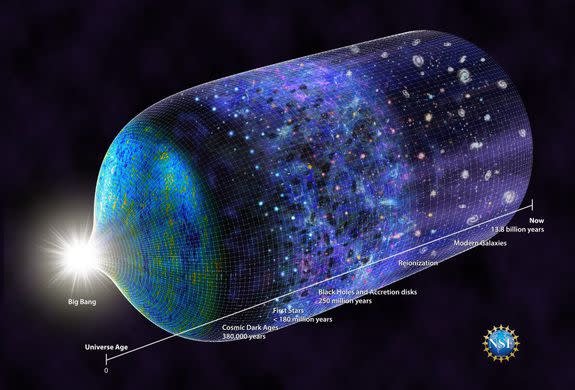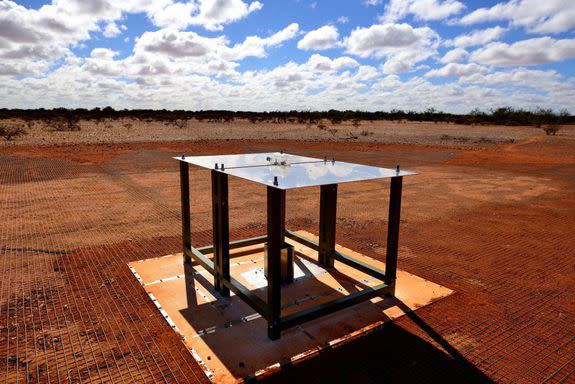Scientists uncover a signal sent out by the first stars in the universe

For millions of years after the Big Bang, the universe was a cold place filled with hydrogen and helium created at the dawn of the universe.
And then, suddenly, there was light.
For the first time, a team of astronomers think they've detected a signal from some of the first stars that formed less than 180 million years after the Big Bang.
Two new studies published in the journal Nature this week detail new evidence about when those stars formed after the Big Bang.
SEE ALSO: Mysterious cosmic radio burst spotted in real time from Australia
The new work also opens up questions about those early eons after the universe came to be, and may even reveal cracks in our understanding of physics.
The researchers behind the new work didn't directly see those first stars bursting into being, but they did detect a faint signal showing hydrogen gas interacting with those first stars, effectively allowing the gas to be seen at various radio frequencies.

Image: N.R.Fuller, National Science Foundation
"Finding this miniscule signal has opened a new window on the early universe,” astronomer Judd Bowman of the University of Arizona, and lead author of one of the new studies said in a statement.
"Telescopes cannot see far enough to directly image such ancient stars, but we've seen when they turned on in radio waves arriving from space," he said.
How they did it
Bowman and his team made these measurements thanks to a small radio antenna in Australia, called EDGES, which was able to detect the faint signals from the first stars because of its remote location, far from radio signals created by humans.
What Bowman and his colleagues saw in the data appeared to confirm that those first stars formed just 180 million years after the Big Bang.
The appearance of the radio waves also seems to match the way that signal is expected to look, according to theoretical models, the study says.
“The signature of this absorption feature is uniquely associated with the first stars,” Haystack Observatory director Colin Lonsdale, who is not an author of the study but does work on instrumentation that enabled it, said in a statement.
“Those stars are the most plausible source of radiation that would produce this signal.”
The research team initially looked for the signal in a different radio wavelength, and when it wasn't found, they moved to another wavelength, where they did find that tell-tale signal created by hydrogen.
Breaking physics as we know it
The new research could also have some bearing on how we understand dark matter — the mysterious form of matter that hasn't been directly observed but seems to dominate 85 percent of the matter in our universe.
In theory, dark matter shouldn't interact with regular matter, but the new study shows evidence that the hydrogen that dominated the early universe was actually much colder than expected, possibly implying that dark matter could have interacted with that early gas.
In short, the new dark matter conclusions — detailed by Tel Aviv University astronomer Rennan Barkana in a separate study — could break physics as we understand it, if validated.
"So far we detected dark matter only through its gravitational effect on visible matter (stars and gas). The existence of some other coupling would indicate new physics and help decipher the enigmatic nature of dark matter," Harvard-Smithsonian Center for Astrophysics astrophysicist Avi Loeb said via email.
"It is possible, for example, that some fraction of the dark matter has a slight electric charge, so small that we would never detect it in environments other than the cosmic dawn," Loeb, who wasn't associated with the study, added.
What's next?
That said, this work is far from over.
Scientists will have a long future in front of them filled with astrophysics experiments that will hopefully help figure out exactly what's going on with this data.

Image: CSIRO Australia
"Extraordinary claims require extraordinary evidence," Loeb said.
"The key for future research on this exciting frontier of the cosmic dawn would be to test the Bowman et al. result with other independent experiments."
Those new experiments should be coming online in the coming years as well.
While the new studies effectively detail the results from looking at this hydrogen signal in one dimension, other observatories like the Square Kilometre Array will be able to look at that signal in 3D, according to Loeb, hopefully illuminating exactly what was going on in that early epoch of the universe.
"We should be guided by additional experiments. With future observations we will not only test the reality of the Bowman et al. signal but also be able to map the hydrogen in three dimensions..." Loeb said.
"The details of future data will reveal whether there is excess cooling and if so whether it originates from the coupling between dark matter and hydrogen."
